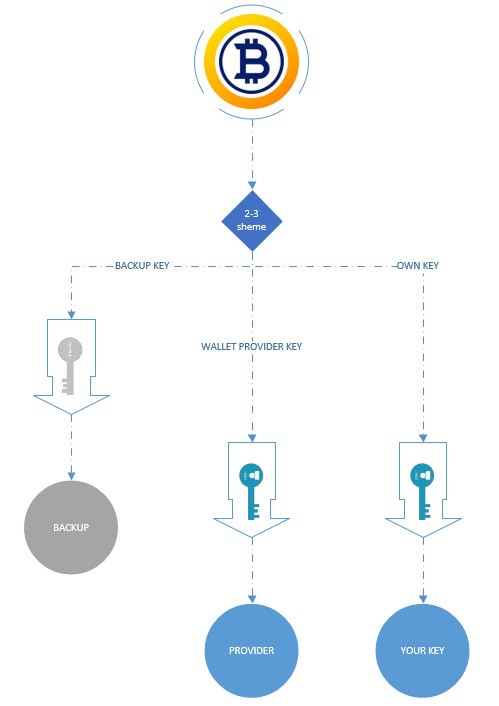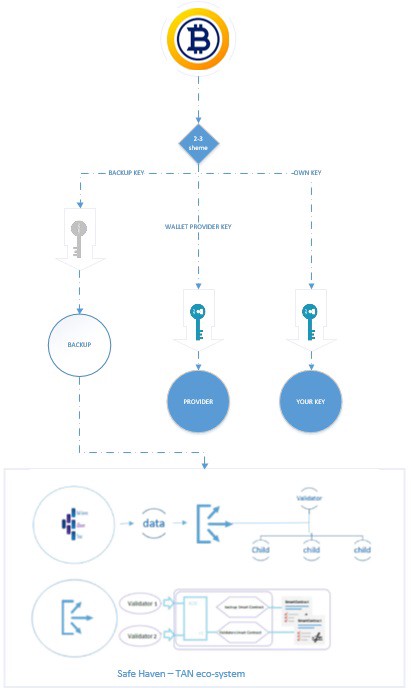Concept:
Multisignature is a digital signature scheme, which allows a group of users to sign a single document. Usually, a multi signature algorithm produces a joint signature that is more compact than a collection of distinct signatures from all users.
Multi signature can be considered as generalization of both group and ring signatures.
Multi signature (multisig) is a form of technology used to add additional security for cryptocurrency transactions. Multi signature addresses require another user or users to sign a transaction before it can be broadcast onto the block chain. The required number of signatures is agreed prior, once people agree to create the address.
Multi signature allows the creation of 2-of-3 escrow services. For example: Alice wants to pay Bob. She sends a transaction to a multi signature address, which requires at least two signatures from the group: “Alice, Bob and Trent” to redeem the money. If Alice and Bob disagree on who should get the money (Alice wants a refund, while Bob believes he fulfilled his obligations and demands the payment), they appeal to Trent. Trent grants his signature to Alice or Bob, so one of them can redeem the funds.
Adoption:
The number of people choosing multisig wallets over standard (single key) wallets is steadily on the rise. As more wallet and exchange services come online offering multisig support, we should expect the rate of adoption to increase even faster, until multisig is the standard for almost all wallets.
How have the individual users and services configured their wallets for security? There are many different ways to do so, from setting the number of keys, enabling two-factor identification (2FA), restricting the platform, to setting the rules on when and by whom the transaction is to be signed. Adding 2FA to any wallet adds another layer of protection. In essence, 2FA acts like an extra key, in your control, as part of the multisig transaction.
How Many Keys?
The most useful arrangement of multisig wallet to the mainstream today is the 2-of-3 wallet, meaning that there are three keys in total, but it only takes two keys to sign transactions for spending from that wallet. The reason this style is the most useful so far is because it is more safe for holders to have their wallet provider hold only 1 key to perform its’ service, while the holder controls enough keys to be able to take his/her wallet elsewhere if anything should go wrong, such as when the wallet provider goes out of business or is hacked.
Oddly enough, 2-of-2 has been the most popular wallet arrangement, at least in terms of how many wallet providers are using it. These wallet services hold on to one key, you have the only other key, and it takes both to sign any transaction. There is no backup key.
This presents a situation where the advantage in using multi signature wallets is minimized. With no backup keys, one would only be protected against a hacker on his/her local machine. There is no protection against any negative action from complete loss of a wallet provider. Nor is there protection from even a simple loss of ones own key. Still, for people whose chief concern is hacking, but with little fear of losing either their key or their wallet provider, this arrangement is advantageous.
With this 2-of-3 wallet one can hold on to two of the keys and be in total control over the fate of those coins. The wallet provider will not be able to spend any without one of his/her two keys being presented at all, but can spend without them if one needed to. Since we can simply print out the third key, and keep it stored away from our computers, even a hacker on ones computer that finds ones private key won’t be able to spend it themselves.


What happens in the case of the user of the wallet dies or has a serious illness? Funds can be locked forever.
Safe Haven Provides the Solution:
In order to protect one’s digital assets, we at Safe Haven give our holders the opportunity to do so without locking oneself out. Seeds / private-keys / passphrases can be shared amongst stakeholders or children in a transparent and secure way.
Safe Haven’s Family Circle is a group that can be composed of anyone the user chooses from family to friends or stakeholders. The TFC SDP is a protocol developed by Safe Haven in order to establish a circle of trust in our ecosystem. Take for instance a dealer (the person that wants to protect his legacy) and players (his children and the validator [legal entity]). The dealer will divide his seeds/key into several share, so if anything ever happens to the user, his children can reconstruct the key by merging their shares, but not without the share of the validator, which through a smart contract, is store on the block chain in a secure and transparent manner.


In case you want more to know more about how we achieve this and our other solutions and use cases, check out our website https://safehaven.io and join our social media channels.
Back to newsJoin our Official Telegram Channel: https://t.me/safehavenio
Follow us on Twitter: https://twitter.com/safeHavenio
Follow us on Facebook: https://www.facebook.com/SafeHaven.io



